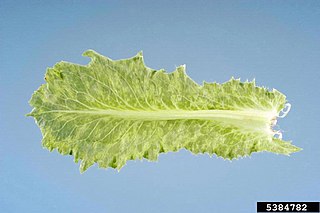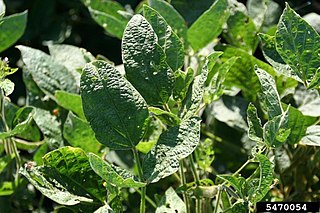
Potyviridae is a family of positive-strand RNA viruses that encompasses more than 30% of known plant viruses, many of which are of great agricultural significance. The family has 12 genera and 235 species, three of which are unassigned to a genus.

Plum pox, also known as sharka, is the most devastating viral disease of stone fruit from the genus Prunus. The disease is caused by the plum pox virus (PPV), and the different strains may infect a variety of stone fruit species including peaches, apricots, plums, nectarine, almonds, and sweet and tart cherries. Wild and ornamental species of Prunus may also become infected by some strains of the virus.

Potyvirus is a genus of positive-strand RNA viruses in the family Potyviridae. Plants serve as natural hosts. Like begomoviruses, members of this genus may cause significant losses in agricultural, pastoral, horticultural, and ornamental crops. More than 200 species of aphids spread potyviruses, and most are from the subfamily Aphidinae. The genus contains 190 species and potyviruses account for about thirty percent of all currently known plant viruses.

Papaya ringspot virus (PRSV) is a pathogenic plant virus in the genus Potyvirus and the virus family Potyviridae which primarily infects the papaya tree.
Asparagus virus 1 (AV-1) is one of the nine known viruses that infects asparagus plants. It is a member of the genus Potyvirus in the family Potyviridae. Initially reported by G. L Hein in 1960, it causes no distinct symptoms in asparagus plants. The only known natural plant host is the asparagus. It is spread by aphid vectors, which means that aphids do not cause the AV-1, but they do spread it.

Bidens mottle virus (BiMoV) is a pathogenic plant virus in the plant virus family Potyviridae. BiMoV is a flexuous filamentous particle, 720 nm long, and belongs to the Potyviridae genus Potyvirus. Like other viruses in this genus, Bidens mottle virus is transmitted both mechanically by sap and by aphids in a stylet-borne fashion.

Cucumber mosaic virus (CMV) is a plant pathogenic virus in the family Bromoviridae. This virus has a worldwide distribution and a very wide host range, having the reputation of the widest host range of any known plant virus. It can be transmitted from plant to plant both mechanically by sap and by aphids in a stylet-borne fashion. It can also be transmitted in seeds and by the parasitic weeds, Cuscuta sp. (dodder).
Pepper mottle virus (PepMoV) is a plant pathogenic virus in the genus Potyvirus and the virus family Potyviridae. Like other members of the Potyvirus genus, PepMV is a monopartite strand of positive-sense, single-stranded RNA surrounded by a capsid made for a single viral encoded protein. The virus is a filamentous particle that measures about 737 nm in length. Isolates of this virus has been completely sequenced and its RNA is 9640 nucleotides long. This virus is transmitted by several species of aphids in a nonpersitant manner and by mechanical inoculation.

Soybean mosaic virus (SMV) is a member of the plant virus genus Potyvirus. It infects mainly plants belonging to the family Fabaceae but has also been found infecting other economically important crops. SMV is the cause of soybean mosaic disease that occurs in all the soybean production areas of the world. Soybean is one of the most important sources of edible oil and proteins and pathogenic infections are responsible for annual yield losses of about $4 billion in the United States. Among these pathogens, SMV is the most important and prevalent viral pathogen in soybean production worldwide. It causes yield reductions of about 8% to 35%, but losses as high as 94% have been reported.
Sweet potato feathery mottle virus (SPFMV) is a member of the genus Potyvirus in the family Potyviridae. It is most widely recognized as one of the most regularly occurring causal agents of sweet potato viral disease (SPVD) and is currently observed in every continent except Antarctica. The number of locations where it is found is still increasing; generally, it is assumed that the virus is present wherever its host is. The virus has four strains that are found in varying parts of the world.
Apium virus Y (ApVY) is a plant pathogenic virus in the genus Potyvirus and the virus family Potyviridae.

Celery mosaic virus (CeMV) is a plant pathogenic virus in the genus Potyvirus and the virus family Potyviridae .
Commelina mosaic virus (CoMV) is a plant pathogenic virus in the genus Potyvirus and the virus family Potyviridae. Like other members of the Potyvirus genus, CoMV is a monopartite strand of positive-sense, single-stranded RNA surrounded by a capsid made for a single viral encoded protein. The virus is a filamentous particle that measures about 707-808 nm in length. This virus is transmitted by two species of aphids, Myzus persicae and Aphis gossypii, and by mechanical inoculation.

Peronospora destructor is a plant pathogen. It causes downy mildew on leaves of cultivated and wild Allium. Allium cepa is most often affected, while Allium schoenoprasum (chives) and Allium porrum (leek) are only occasionally affected.
Narcissus degeneration virus (NDV) is a plant pathogenic Potyvirus of the family Potyviridae which infects plants of the genus Narcissus. It is one of the most serious and prevalent of the approximately 21 viruses which infect this genus.NDV is associated with chlorotic leaf striping in N. tazetta.
Carrot virus Y (CarVY) is a (+)ss-RNA virus that affects crops of the carrot family (Apiaceae), such as carrots, anise, chervil, coriander, cumin, dill and parsnip. Carrots are the only known crop to be infected in the field. Infection by the virus leads to deformed roots and discolored or mottled leaves. The virus is spread through insect vectors, and is currently only found in Australia.
Leek yellow stripe virus (LYSV) belongs to the genus Potyvirus. It was first detected in leek but also infects garlic and onion worldwide. Economically less important Allium spp., such as Allium angulosum, Allium caeruleum, Allium cyathophorum, Allium nutans, Allium scorodoprasum, Allium senescens subsp. montanum were also found to harbor the virus.
Garlic common latent virus (GarCLV) is a plant virus member of the genus Carlavirus that has been found infecting garlic globally. Detection of the virus in leek and onion has also been reported.
Shallot latent virus (SLV), a species of Carlavirus, was first identified in shallots in Netherlands. The virus particle is elongated, 650 nm in length.

Puccinia porri is a species of rust fungus that causes leek rust. It affects leek, garlic, onion, and chives, and usually appears as bright orange spots on infected plants.








